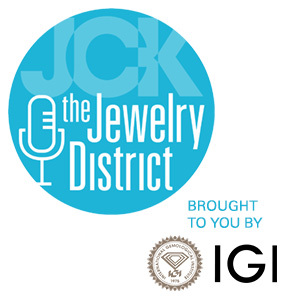
On this week’s episode, JCK editor-in-chief Victoria Gomelsky and news director Rob Bates recap highlights from 24 Karat Weekend, including takeaways from The Plumb Club’s Symposium ’25. Rob brings listeners up to speed on how the ever-changing tariff news could affect the jewelry industry and shares the latest on the ongoing battle between lab-grown and natural diamonds. Finally, Victoria discusses the most talked-about rumors and reports from the watch world, including acquisitions, major management shifts shaking up the top players, and buzz about a potential new line from Rolex.
Sponsored by IGI: igi.org/education
Episode Credits
Hosts: Rob Bates and Victoria Gomelsky
Producer and engineer: Natalie Chomet
Editor: Riley McCaskill
Plugs: @jckmagazine; igi.org/education
Show Notes
01:36 Symposium ’25 Spotlights Leadership Success Skills
06:30 Hot Topics: Trade Wars and Diamonds
14:57 What Really Fueled the Lab-Grown Frenzy?
19:55 A Breitling Buy, a Rolex Rumor
Show Recap
Symposium ’25 Spotlights Leadership Success Skills
Victoria and Rob share highlights from NYC Jewelry Week, including The Plumb Club’s Symposium ’25, where Victoria attended a seminar by best-selling author and workplace strategist Erica Keswin called “Becoming a Good Human Leader in the Age of AI.” While Erica’s seminar was not jewelry-specific, she shared three principles leaders can use to help any business succeed. She says all great human leaders connect their people to a sense of purpose, to one another, and to themselves.
Victoria particularly enjoyed the Q&A, where she heard retailers discuss the ways they implement Erica’s principles at their stores, from a staff trip to Tulum to in-store morning rituals for an entire team. “What I always take away from these meetings where I overhear retailers is how critical this human resource element is to their jobs as owners and store managers,” says Victoria.
Hot Topics: Trade Wars and Diamonds
Two topics dominated 24 Karat Weekend conversations, Rob reports. The first was tariffs and trade wars. While it’s hard to gauge the impact tariffs will have on the U.S. economy because the situation is continually changing, the new administration’s actions are clearly reverberating, Rob observes.
“It’s not clear exactly what the [tariff] endgame is,” Rob says. “I don’t think it’s even clear what the middle or beginning game is…. What does seem clear is that jewelry will be impacted in some way.”
The most obvious fallout may be that because tariffs raise prices, consumers will be left with less money to spend on purchases like jewelry. It’s harder to predict the potential effect of Canada’s plan to impose tariffs on U.S. jewelry and the EU’s plan to put tariffs on U.S. diamond exports to Europe. Rob explains that while the U.S. exports a sizable number of diamonds, tariffs are usually based on country of origin—not country of export. It’s unclear how much U.S. jewelry would be affected by tariffs because it might not be considered a product manufactured in the United States, he says.
The second hot topic at the show was an evergreen one: lab-grown versus natural diamonds. There was a general sense that retailers had a fairly good year, while suppliers struggled in 2024, particularly those who deal in lab-grown or natural diamonds, Rob reports. People seem to agree that the natural diamond market has bottomed out and there may be slow signs of improvement. Botswana’s mining minister Bogolo Kenewendo told Rob her team is seeing a marginal improvement in natural diamond sales after months of decline.
The consensus is that the natural diamond industry must overhaul its approach to marketing. “The natural industry has historically always relied on De Beers and diamond producers to get the message out,” Rob says. “I think what people are starting to come to grips with [is that] every part of the chain has to play its part.”
But winning back market share won’t be easy. With about 50% of all engagement ring purchasers opting for lab-grown stones, natural diamond suppliers are wondering how to recapture market share and who will pay for any marketing.
On a more optimistic note, Rob says there’s a lot of passion among those in the natural diamond business to tell their story. “You saw that early on with people in the lab-grown business, especially people who believed that they were saving the world,” Rob says. “Now you’re starting to see that being matched by people in natural.” Still, no matter how ardently you believe in a product, marketing requires money, and “it’s just not clear how these things are going to be funded.”
What Really Fueled the Lab-Grown Frenzy?
Victoria recently interviewed former Jewelry District guest and diamond analyst Paul Zimnisky, who told her he sees the narrative about lab-grown diamonds changing as people recognize that prices have reached rock bottom.
Paul believes much of the growth in the lab-grown sector was driven not by consumer demand but by retailers “a bit drunk on” the margins lab-grown stones provide, as Victoria puts it. She says his observation surprised her. “I always just assumed that demand was bubbling up from the market itself, from consumers,” she says.
Rob believes it’s hard to know how much retailers are driving the product into consumers’ hands. “For a long time, retailers were making a lot of money on lab-grown, and they were incentivized to sell it,” he explains. “And it’s an easier sale because it’s a cheaper sale.” On the other hand, some retailers have told him they don’t like lab-grown product and never planned to carry it, but had to because people kept asking for it. Still, he concludes, “if those margins weren’t there, we wouldn’t be where we are.”
Paul believes that retailers who sell lab-grown product should segregate it from natural diamonds, Victoria says, noting that Zachary’s Jewelers recently did this, opening a separate lab-grown-only store. “That seems like the right strategy,” she says. “There’s nothing wrong with them as a product, but don’t confuse your clientele. Don’t muddy the waters of your own merchandise.”
A Breitling Buy, a Rolex Rumor
With Watches and Wonders Geneva 2025 set to open April 1, there’s been a flurry of news from the watch world.
Breitling recently acquired Gallet, a brand Victoria calls a “sleeping beauty.” People in the vintage community know it well, and “it’s quite sought after,” she says. Victoria believes that this purchase, combined with the company’s 2023 acquisition of Universal Genève, shows that “Breitling is gunning to be one of the big players in the watch world.” The brand is close to cracking the billion-dollar mark that separates the power players from the rest of the field, she says.
Also generating buzz were several Rolex leaks, including rumors that the brand had trademarked the name Land-Dweller and plans to introduce a new line revitalizing a classic 1970s case design with an integrated bracelet and Oysterquartz movement. While Victoria doesn’t know if the rumors are true, she says that “a new collection from Rolex would be a big deal.”
In other news, beloved Panerai CEO Jean-Marc Pontroué announced on social media that he had left the Richemont Group after 25 years. Stepping into his role is longtime Richemont exec Emmanuel Perrin. Given that no one wants their company to generate buzz for its management changes rather than its exciting new product a week before the industry’s most important trade show, the switch doesn’t instill “confidence in what the Richemont Group is doing,” she says.
Rob mentions that LVMH, too, generated buzz recently by transferring Frédéric Arnault from its watch division to another group. He wonders whether Richemont is planning to restructure its watch division and, if so, whether it’s part of a larger trend among companies to let watch brands operate independently. That’s possible, Victoria says, noting that the successful watch brands have been “independent of corporate group ownership.”
Any views expressed in this podcast do not reflect the opinion of JCK, its management, or its advertisers.
- Subscribe to the JCK News Daily
- Subscribe to the JCK Special Report
- Follow JCK on Instagram: @jckmagazine
- Follow JCK on X: @jckmagazine
- Follow JCK on Facebook: @jckmagazine




